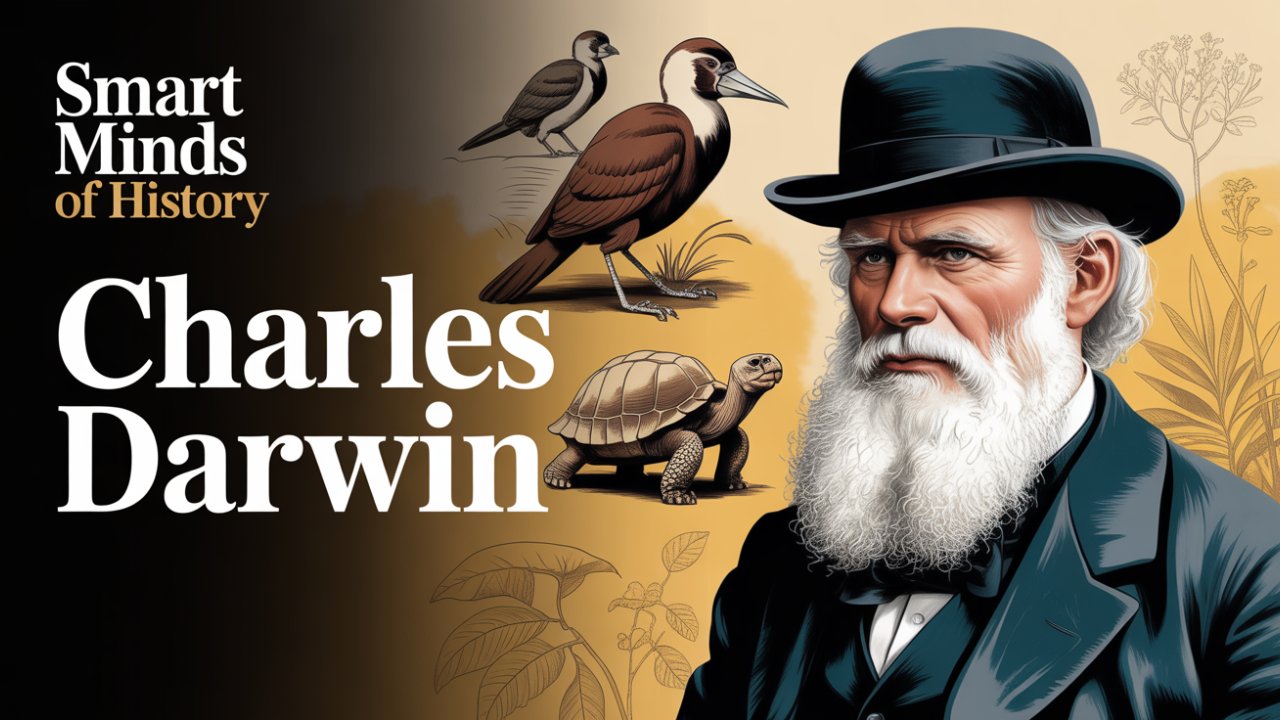He was a disappointment to his father a medical school dropout with no clear future. His early life was a story of quiet rebellion, of drifting away from the respectable path laid out for him. But a single voyage to the far corners of the earth would change everything. This journey wouldn’t just transform the aimless young man into a titan of science; it would lead to a discovery that forever redefined how we see ourselves and our place in the universe. This is the story of how a reluctant naturalist embarked on a world-changing voyage and returned with an idea so powerful it would shake the very foundations of society, launching a revolution in thought that’s still going on today. This is the story of Charles Darwin.
Before Darwin, the world seemed… fixed. A perfect creation where every species was designed for its purpose, unchanged since the dawn of time. But what if that elegant certainty was just an illusion? What if life wasn’t a static masterpiece, but a sprawling, chaotic, and unending story of struggle, adaptation, and change? Darwin’s work proposed exactly that, offering a new genesis story one written not in scripture, but in the rocks, fossils, and living creatures of our planet. It’s a story of a shared ancestry connecting every living thing, from the humblest beetle to us, shaped not by a guiding hand, but by the blind, relentless force of natural selection.
To get a handle on the man who would upend the world, we first have to go to the quiet, green countryside of Shrewsbury, England. Charles Robert Darwin was born on February 12, 1809, into a world of wealth and intellectual curiosity. His family was well-connected, and his father, Dr. Robert Darwin, was a towering figure a successful and imposing physician with very high expectations for his kids. The intellectual roots ran deep. His grandfather, Erasmus Darwin, was a famous physician, inventor, and poet who, decades earlier, had actually flirted with the idea of evolution in his own writings, planting a seed that would one day blossom spectacularly in his grandson.
From his earliest days, young Charles was way more interested in the living world around him than in his school lessons. While other boys were buried in their books, Darwin was out collecting birds’ eggs, shells, minerals, and especially beetles. He was, by his own account, a pretty ordinary kid who found the classical curriculum at Shrewsbury School with its endless Latin and rote memorization incredibly dull. He later wrote, “I was considered by all my masters and by my father as a very ordinary boy, rather below the common intelligence.” Coming from the man who would change biology forever, that says a lot about his early struggles.
His father, seeing a son who seemed to care only about “shooting, dogs, and rat-catching,” decided a career in medicine was the answer. So, at 16, Darwin was shipped off to the prestigious University of Edinburgh to follow in his father’s footsteps. It didn’t take. The lectures were boring, but it was the operating theater that truly horrified him. This was an era before anesthetics, and surgery was a brutal, bloody affair. The screams of patients were more than the sensitive young Darwin could handle. He fled the lecture hall, sickened, and soon gave up on medicine altogether a huge disappointment to his formidable father.
Dr. Darwin, ever the pragmatist, came up with a Plan B. If his son wouldn’t be a doctor, he’d be a clergyman. It was a respectable, stable job for a gentleman, and it would leave him plenty of time for his little “hobby” of natural history. In 1828, Charles was sent to Christ’s College, Cambridge, to get a Bachelor of Arts degree, the first step toward joining the Anglican Church.
At Cambridge, Darwin’s life finally clicked into place. While he went through the motions of his theology studies, his real education was happening outside the classroom. He fell in with a crowd of guys who shared his passion for nature. Most importantly, he became close friends with a botany professor named John Stevens Henslow. Henslow was a brilliant mentor who saw past Darwin’s academic indifference and recognized his sharp eye and boundless curiosity. He took Darwin under his wing, inviting him to dinners with famous scientists and taking him on long walks to talk botany and geology. Thanks to Henslow, Darwin’s passion for science was forged into a serious pursuit. He also became a huge fan of the geologist Adam Sedgwick, who took him on a geological tour of Wales, teaching him how to read the Earth’s history in its rock formations.
He wasn’t just a beetle collector anymore; he was becoming a real naturalist, learning the disciplines of careful observation and critical thinking. He’d found his calling, even if he didn’t know where it would lead. He finished his degree, but the future still looked like a quiet life as a country parson. But then, a letter arrived, forwarded by his mentor, Professor Henslow. It contained an invitation an opportunity so extraordinary it would reroute the course of his life and, with it, the course of science itself.
The letter that landed in Darwin’s hands in August 1831 was the offer of a lifetime. Captain Robert FitzRoy, a stern, aristocratic, and deeply religious man, was prepping the HMS Beagle for a two-year mission to chart the coast of South America. FitzRoy was looking for a “gentleman naturalist” to join the voyage someone to collect specimens and, just as importantly, to be an educated companion for the captain on the long, lonely journey. Professor Henslow had been offered the spot first, but when he couldn’t go, he immediately recommended his promising young protégé.
Darwin was ecstatic. This was the ultimate adventure, a chance to see the tropics and study the exotic wildlife he’d only read about. But his father was furious. He saw the voyage as just another pointless distraction, a “wild scheme” that would only delay his son’s career and bring shame on the family. He flat-out forbade Charles from going.
Dejected, Darwin wrote to decline the offer. But he had one last ally: his uncle, Josiah Wedgwood II. Darwin rode over to the Wedgwood estate to plead his case. His uncle listened patiently and, seeing the incredible opportunity, wrote a carefully reasoned letter to Dr. Darwin, systematically taking apart every single one of his objections. That appeal, from a man Robert Darwin deeply respected, finally did the trick. He caved, agreeing not only to let his son go but also to pay for his trip. The reluctant hero’s adventure was officially on.
Now, the HMS Beagle wasn’t some grand vessel of exploration. It was a cramped, 90-foot brig-sloop, basically a small warship refitted for a survey mission. Darwin’s quarters were ridiculously small; he shared a space where he had to literally remove a drawer to make room for his feet in his hammock. For a man who was around six feet tall, the conditions were rough. The voyage, planned for two years, would end up stretching to nearly five, circumnavigating the globe. It was a journey filled with danger, from violent storms and treacherous seas to political uprisings and the constant threat of disease. On top of all that, Darwin suffered from terrible seasickness for much of the time he was at sea.
On December 27, 1831, the HMS Beagle sailed from Plymouth. Aboard was a 22-year-old recent graduate who, officially, still planned to become a parson when he got back. But as the shores of England faded behind him, he was sailing toward a very different destiny. He was leaving a world of fixed ideas, and heading straight into a world of discovery that would give him a lifetime of evidence to ponder and plant the seeds of a theory that would forever change our view of life on Earth.
The five-year voyage of the Beagle was the ultimate training ground where Darwin’s revolutionary ideas were forged. He spent over three years of the trip on land, tirelessly exploring, collecting, and observing. Every new rainforest, every fossil bed, was a classroom, revealing a world that was far more complex, ancient, and dynamic than he’d ever imagined.
The first major stop was South America, and it was here that Darwin’s worldview really started to shift. In Argentina, while exploring the dry riverbeds of Patagonia, he made a stunning discovery: the fossilized bones of gigantic extinct mammals. He found the Megatherium, a giant ground sloth the size of an elephant, and the Glyptodon, a colossal armored beast that looked like a super-sized armadillo. What blew Darwin’s mind wasn’t just their size, but how much they looked like the much smaller sloths and armadillos still living there. It was like he was looking at their ancient, giant relatives. This raised a huge question: if species were created fixed and unchanging, why did these giant versions disappear, and why did the living animals in the exact same place look so much like them? It was the first powerful clue of what he would later call “descent with modification.”
Geology gave him another massive piece of the puzzle. Darwin had brought along the first volume of Charles Lyell’s Principles of Geology. Lyell argued that the Earth wasn’t shaped by sudden, violent disasters, but by slow, gradual processes erosion, sedimentation, volcanic activity acting over immense spans of time. This idea of “deep time” was a game-changer. Then, in Chile, Darwin experienced these forces firsthand. He witnessed a massive earthquake that violently shook the coast and saw with his own eyes that the land itself had been raised several feet. High in the Andes mountains, he found beds of marine shells clear proof that what was once the sea floor had been slowly pushed skyward over eons. Lyell’s theory wasn’t just an idea in a book; it was a reality he could see and touch. This geological dynamism meant the world wasn’t static, and it provided the vast timescale millions and millions of years that would be necessary for a slow, gradual process like evolution to happen.
As the Beagle sailed on, Darwin also noticed strange patterns in where living species were found. He saw two similar but distinct species of rheas, those big, flightless birds, whose territories were separated by a river. Why would there be two slightly different versions of the rhea living right next to each other? And why were the animals and plants in South America so different from those in Europe, even in places with similar climates? These questions of biogeography the study of where species live and why started to chip away at the idea that species were perfectly designed for their environments. It seemed like geography and ancestry had a lot more to do with it.
But it was in the fall of 1835, at a tiny, remote chain of volcanic islands 600 miles off the coast of Ecuador, that all these ideas started coming together. The Galapagos Islands were a world unto themselves, a living laboratory of evolution. Darwin was floored by the unique wildlife. He saw giant tortoises with shells shaped differently on each island, and marine iguanas, which he called “imps of darkness,” that swam in the sea.
He collected mockingbirds from different islands and was struck by the fact that they all seemed to be distinct varieties, maybe even different species. This was a critical moment. He wrote in his notes that if these varieties were on their way to becoming new species, “such facts would undermine the stability of Species.”
And then there were the finches. Ironically, Darwin didn’t realize how important these small, drab little birds were at first. He collected them from different islands but made the mistake of not carefully labeling which bird came from which island a slip-up he’d later kick himself for. He noted the incredible variety in their beak shapes some thick for cracking nuts, others slender for probing for insects but he initially thought they were different kinds of birds altogether, like wrens or grosbeaks.
The “eureka” moment didn’t happen on the Galapagos. It came months later, back in London. He showed his specimens to an expert ornithologist, John Gould, who delivered the stunning news: these weren’t different types of birds. They were all finches, a whole new group of more than a dozen distinct species, each unique to the Galapagos. The implication was mind-boggling. A single ancestral species of finch must have come to the islands from the mainland long ago. Over time, its descendants spread to the different islands, and in isolation, each group had adapted to the food available, their beaks slowly changing over countless generations. The Galapagos finches were a perfect, miniature model of how one species could branch out and become many. The voyage was over, but the real intellectual journey was just beginning. Darwin returned to England in October 1836, no longer a young man planning to be a parson, but a seasoned and celebrated naturalist, carrying a set of radical, world-changing questions.
Darwin came back to England a different person. The five-year voyage had made him a respected figure in the scientific community. He wasn’t living in his father’s shadow anymore; he was a scientist in his own right, celebrated for the incredible collections he’d sent home. He dove into the massive task of sorting through his specimens, working with the top experts of the day, like John Gould, whose work on the finches had been so critical.
All the pieces of the puzzle were laid out in front of him: the fossil giants that looked like living species, the geological proof of an ancient, changing Earth, and the strange distribution of animals, especially those revelatory finches from the Galapagos. He was now convinced that species were not fixed, that they changed over time. He called this idea “transmutation,” and it became the central secret of his life’s work. But he was still missing a key piece: the how. How did this change actually happen? It’s one thing to believe species evolve, but it’s another thing entirely to explain the mechanism.
The breakthrough came from a rather unlikely place. In the fall of 1838, Darwin was reading a book for “amusement” An Essay on the Principle of Population by the economist Thomas Malthus. Malthus argued that human populations, if left unchecked, will always grow faster than their food supply, leading to a fierce “struggle for existence,” where things like poverty, famine, and disease keep the numbers down.
As Darwin read this, it hit him like a bolt of lightning. He realized this principle didn’t just apply to humans it applied to everything in nature. Every plant and animal produces way more offspring than can possibly survive. A single poppy can make thousands of seeds. He even calculated that a single pair of elephants, the slowest breeders around, could theoretically produce around 19 million descendants in 750 years if they all survived. Yet, the world isn’t overrun with poppies or elephants. Why? Because there’s a constant struggle for life a battle for food, a fight to escape predators, a war against disease.
In this universal struggle, who gets to survive and reproduce? Darwin realized that within any population, there’s natural variation. Some individuals, just by chance, are born with traits that give them a tiny edge a slightly longer beak, a thicker coat, better camouflage. These individuals would be more likely to survive the struggle and, most importantly, pass those helpful traits on to their kids. Those with unfavorable traits would be more likely to die off. He called this process natural selection. It was a simple, yet incredibly powerful mechanism that, over vast stretches of geological time, could not only change a species but create entirely new ones. “Here, then,” he wrote, “I had at last got a theory by which to work.”
He had his mechanism. But instead of rushing to publish this explosive idea, Darwin did something amazing: he waited. For more than twenty years, he kept his theory mostly to himself, sharing it with only a few trusted friends. So why the long delay?
Part of it was just his cautious, meticulous nature. Darwin knew his theory would be met with fierce opposition, and he wanted to build a mountain of evidence so high that it couldn’t be ignored. He was determined to anticipate every possible objection.
Another big reason was fear. The idea of evolution was practically heresy in Victorian England. It challenged the cherished belief in divine creation and the special, elevated place of humans in the universe. Suggesting that life, including us, had evolved from “lower” forms through a blind, natural process was asking for public ridicule and condemnation.
Finally, Darwin was plagued by a mysterious and debilitating chronic illness. He suffered from severe nausea, heart palpitations, and extreme fatigue that would torment him for the rest of his life. This illness often left him unable to work for more than a few hours a day, which dramatically slowed him down.
So, he retreated. In 1842, he and his new wife, his cousin Emma Wedgwood, moved to Down House, a quiet country estate in Kent. This house became his sanctuary, his lab, and the center of his world for the next forty years. Away from the bustle of London, he lived the life of a reclusive scientist. He sketched out a preliminary version of his theory in 1842 and a longer essay in 1844, which he gave to his wife with instructions to publish it if he died.
His home and gardens became his experimental playground. He spent eight years conducting painstaking research on barnacles, becoming one of the world’s foremost experts on these tiny crustaceans just to bolster his credentials. He bred pigeons, showing how artificial selection could create dramatic changes in a short time, a powerful analogy for natural selection. He studied carnivorous plants, climbing plants, and even humble earthworms, all in an effort to gather more evidence for his grand theory. For twenty years, the idea of natural selection simmered, waiting for the right moment to finally come into the light.
If you’re finding this journey into Darwin’s revolutionary mind as fascinating as we are, take a moment to subscribe and click the bell icon. You won’t want to miss our next exploration into the smart minds who dared to change our world.
Darwin might have kept up his slow, methodical work for years, if not for a letter that arrived at Down House in June of 1858. It came from halfway around the world, from the Malay Archipelago. The sender was a young, brilliant, and relatively unknown naturalist named Alfred Russel Wallace.
Wallace, like Darwin, was a passionate field biologist who had spent years traveling and collecting. And, like Darwin, he had been deeply influenced by the writings of Lyell and Malthus. While suffering from a malarial fever on a remote island, the very same idea that had struck Darwin two decades earlier flashed into Wallace’s mind: the struggle for existence, combined with natural variation, must lead to the survival of the fittest and the evolution of new species.
Excited, Wallace quickly wrote up an essay outlining his theory. Remembering an encouraging letter he’d once received from the eminent Charles Darwin, he decided to send the manuscript to him, asking for his opinion and to forward it to Charles Lyell if he thought it was any good.
When Darwin opened the package and read Wallace’s essay, his world turned upside down. He was completely floored. “I never saw a more striking coincidence,” he wrote to Lyell. “If Wallace had my M.S. sketch written out in 1842, he could not have made a better short abstract!” To his horror, Wallace’s theory was nearly identical to his own. His life’s work, the secret he had guarded for twenty years, was about to be scooped. He was facing the devastating prospect of losing credit for the greatest discovery of his life.
Darwin was in despair. He was a man of integrity and wanted to do the right thing by Wallace, but he was also desperate to get credit for the theory he had developed in such detail. In the end, his friends, Charles Lyell and the botanist Joseph Hooker, came up with a solution. They proposed a joint presentation to the Linnean Society of London, one of England’s most prestigious scientific bodies.
On July 1, 1858, extracts from Darwin’s 1844 essay and a more recent letter were read aloud, right alongside Wallace’s complete paper. This arrangement made sure both men would share credit for the theory of evolution by natural selection. Ironically, the presentation itself barely made a ripple at the time. The president of the society later remarked that the year had not been marked by any “striking discoveries.”
But for Darwin, the fire was lit. The shock of Wallace’s letter spurred him into action. He abandoned his plans for a massive, multi-volume magnum opus and set about writing a shorter, more accessible “abstract” of his theory. For thirteen months, he worked feverishly, condensing two decades of research into a single, powerful volume.
In November 1859, On the Origin of Species by Means of Natural Selection, or the Preservation of Favoured Races in the Struggle for Life was published. The first print run of 1,250 copies sold out on the very first day. The quiet, reclusive naturalist had finally spoken, and the world was about to listen. The book he had agonized over for so long was out, and the storm of controversy he had always feared was about to break.
The publication of On the Origin of Species didn’t just cause a stir; it ignited a firestorm. The book was an instant sensation, debated not just in scientific circles, but in living rooms, pulpits, and newspapers around the world. Darwin had deliberately side-stepped talking too much about human origins, offering only the provocative understatement that “light will be thrown on the origin of man and his history.” But everybody got the implication: humans weren’t a special creation, separate from the animal kingdom. We were part of the same great tree of life, subject to the same natural laws.
The reaction from scientists was mixed. Some, like the botanist Joseph Hooker and the young, fiery biologist Thomas Henry Huxley, became immediate, passionate champions of the theory. Huxley, in particular, famously declared he was prepared to “go to the stake” for the idea and earned the nickname “Darwin’s Bulldog” for his fierce defense of evolution. Other scientists were skeptical, raising valid questions about the age of the Earth, gaps in the fossil record, and the mechanism of inheritance, which nobody understood yet.
The most famous clash happened in June 1860, at a meeting in Oxford. The debate pitted Bishop Samuel Wilberforce, a slick and charismatic speaker, against Thomas Henry Huxley. Wilberforce, trying to land a cheap shot, famously asked Huxley if it was through his grandfather or his grandmother that he claimed descent from a monkey. Huxley’s legendary comeback sealed the moment in history. He calmly replied that he would not be ashamed to have a monkey for an ancestor, but he would be ashamed to be connected to a man who used his great gifts to obscure the truth. The exchange became a symbol of the profound cultural conflict Darwin’s theory had unleashed a battle between the authority of science and the authority of religion.
For many religious believers, Darwin’s theory was a direct assault on their faith. It seemed to replace a purposeful, divinely ordered world with one governed by chance, struggle, and pitiless law. Darwin himself, who had once been on track to join the clergy, gradually lost his own faith not in a single moment, but through a long, slow process influenced by his scientific work and the tragic death of his beloved daughter, Annie.
Now, it’s really important to get something straight: many of the ugliest ideas later associated with Darwin’s work were not his own. The concept of “Social Darwinism” which twisted “survival of the fittest” to justify imperialism, racism, and ruthless capitalism was a gross distortion of his biological theory. Darwin himself was a compassionate man and a staunch abolitionist who was horrified by slavery. He never saw evolution as a ladder of “progress” leading to humanity, and he certainly didn’t think it provided a moral guide for how to run a society.
In the decades after Origin, the evidence for evolution kept piling up. By the time of Darwin’s death in 1882, the fact of evolution was widely accepted by scientists. Natural selection as the main engine would take longer to be fully embraced, but Darwin’s core idea that all life is connected had permanently changed biology. He spent his final years at Down House, continuing his research and writing books on human evolution, orchids, emotions, and even earthworms.
(Conclusion)
When you look back, Charles Darwin’s story is one of incredible transformation. It’s the story of a young man who drifted without a purpose, who abandoned two careers, and who, through a mix of luck, opportunity, and bottomless curiosity, found his true calling on the far side of the world. He was a quiet, gentle man, a reluctant revolutionary whose radical idea caused a seismic shift in how we understand everything.
His great contribution, the theory of evolution by natural selection, is the unifying principle of all the life sciences. It revealed that life isn’t a collection of fixed things, but a dynamic, interconnected web a three-and-a-half-billion-year-old story of change and adaptation. It gave us a new sense of our place in the universe: not as the pinnacle of creation, but as one small, recent twig on an immense and ancient tree of life.
Darwin’s legacy isn’t just the theory itself; it’s the method he championed: a relentless dedication to evidence, a commitment to observation, and the courage to follow an idea wherever it leads, no matter how uncomfortable the destination. His life shows us that the biggest leaps in understanding often start with the simplest questions, and that even a mind once considered “ordinary” can forever change how we see the world. His work taught us a timeless lesson: in the great story of life, survival belongs to those most responsive to change. And in the history of ideas, few have ever brought about a change so deep, so lasting, and so profound.
What are your thoughts on Charles Darwin’s impact on science and society? Share your perspective in the comments below. And before you go, be sure to check out our playlist on other scientific revolutionaries who dared to see the world differently. Thanks for watching.





